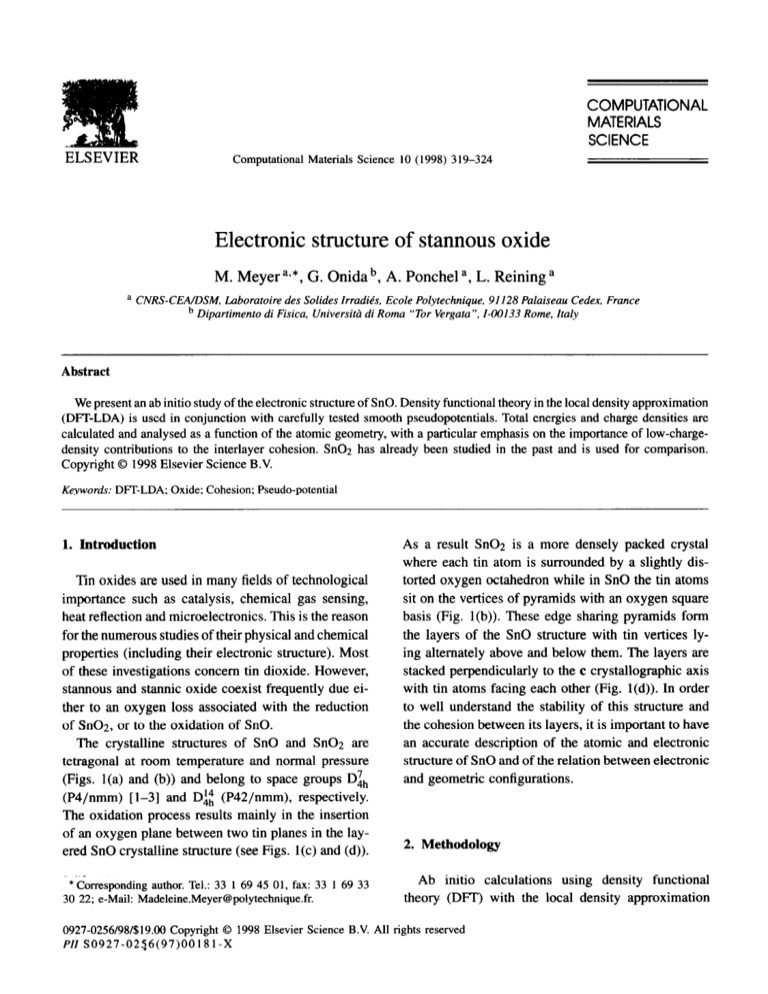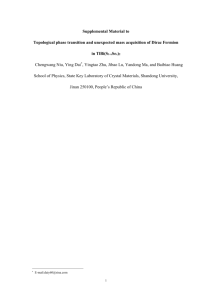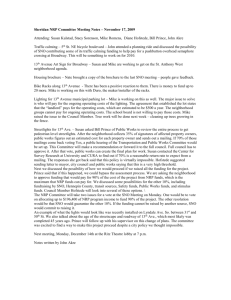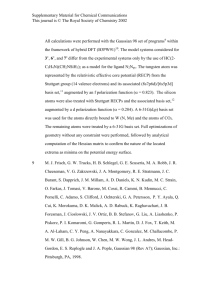
COMPUTATIONAL
MATERIALS
SCIENCE
ELSEVIER
Computational Materials Science 10 (1998) 319-324
Electronic structure of stannous oxide
M. Meyer a,*, G. Onida b, A. Ponchel a, L. Reining a
a CNRS-CEA/DSM,
Laboratoire des Solides Irradiks, Ecole Polytechnique, 91128 Palaiseau Cedex, France
b Dipartimento di Fisica, Universitd di Roma “Tor Vergata’“,I-00133 Rome, Italy
Abstract
We present an ab initio study of the electronic structure of SnO. Density functional theory in the local density approximation
(DFT-LDA) is used in conjunction with carefully tested smooth pseudopotentials. Total energies and charge densities are
calculated and analysed as a function of the atomic geometry, with a particular emphasis on the importance of low-chargedensity contributions to the interlayer cohesion. Sn02 has already been studied in the past and is used for comparison.
Copyright 0 1998 Elsevier Science B.V.
Keywords: DFT-LDA; Oxide; Cohesion; Pseudo-potential
1. Introduction
Tin oxides are used in many fields of technological
importance such as catalysis, chemical gas sensing,
heat reflection and microelectronics. This is the reason
for the numerous studies of their physical and chemical
properties (including their electronic structure). Most
of these investigations concern tin dioxide. However,
stannous and stannic oxide coexist frequently due either to an oxygen loss associated with the reduction
of SnO2, or to the oxidation of SnO.
The crystalline structures of SnO and SnO2 are
tetragonal at room temperature and normal pressure
(Figs. l(a) and (b)) and belong to space groups Dil,
(P4/nmm) [l-3] and Dii (P42/nmm), respectively.
The oxidation process results mainly in the insertion
of an oxygen plane between two tin planes in the layered SnO crystalline structure (see Figs. l(c) and (d)).
*Corresponding author. Tel.: 33 1 69 45 01, fax: 33 1 69 33
30 22; e-Mail: Madeleine.Meyer@polytechnique.fr.
As a result SnO:! is a more densely packed crystal
where each tin atom is surrounded by a slightly distorted oxygen octahedron while in SnO the tin atoms
sit on the vertices of pyramids with an oxygen square
basis (Fig. l(b)). These edge sharing pyramids form
the layers of the SnO structure with tin vertices lying alternately above and below them. The layers are
stacked perpendicularly to the c crystallographic axis
with tin atoms facing each other (Fig. l(d)). In order
to well understand the stability of this structure and
the cohesion between its layers, it is important to have
an accurate description of the atomic and electronic
structure of SnO and of the relation between electronic
and geometric configurations.
2. Methodology
Ab initio calculations using density functional
theory (DFT) with the local density approximation
0927-0256/98/$19.00 Copyright 0 1998 Elsevier Science B.V. All rights reserved
PII SO927-0226(97)0018
1 -X
320
M. Meyer et al./Computational
Materials
Science
10 (1998) 319-324
SnO
Fig. 1. Atomic configurations of SnO;! and SnO, the large spheres correspond to oxygen atoms and the smaller ones to tin atoms:
(a) Structure of Sn02: unit cell. The dashed lines link the 0 atoms forming an octahedron surrounding a tin atom. (b) Structure of
SnO: unit cell. The dashed lines link the 0 atoms and the tin atom forming square-based pyramids. (c) Projection of the SnO2 unit
cell onto a (10 0) plane showing the traces of the alternate 0 and Sn atomic planes. (d) Projection of the SnO unit cell onto a (0 10)
plane showing the traces of the 0 and Sn atomic planes. An extra Sn plane has been added for the sake of comparison with (c).
(LDA) are performed
in order to investigate
the den-
sity of charge in SnO and its evolution with the atomic
configuration.
The Kohn Sham equations [4] are
solved using the Car-Parrinello
(CP) scheme [5] with
normconserving
pseudopotentials
and a plane wave
basis. This approach has been used with great success
for various materials, but, in the case of oxides, the
localised 0 2p states require the use of a largely extended plane wave basis and consequently an important computational effort is necessary. The number of
plane waves can be significantly reduced by the use of
soft pseudopotentials
[6] which have already proved
to be efficient for oxides such as TiO2 [7], SnO;! [8]
and Liz0 [9]. The oxygen soft pseudopotential
created with a core cut-off radius of 1.45 a.u. allows us
to get a good convergence of the total energy with
a kinetic energy cut-off equal to 70Ry.
hard core norm conserving
A standard
pseudopotential
is used
for the tin atoms [lo] and the relative core contribution due to the 4d electrons
a nonlinear core correction
is taken into account via
[ll]. As usual with the
CP method the Kleinman-Bylander
(KB) separable
form of the pseudopotential
[12] is used with the
p and d components
as reference
states for oxygen
and tin, respectively. Eight k points of the irreducible
Brillouin zone are used to calculate the total energy of
the electronic ground state associated with the atomic
positions of tin and oxygen.
The unit cell of SnO contains two molecular units
with atoms located as follows: O(0 0 0; l/2 l/2 0),
Sn(0 l/2 u; l/2 03). There are some discrepancies
between the lattice parameters obtained by powder
M. Meyer et al./Computational Materials Science 10 (1998) 319-324
X-ray data measurements (a = 3.796A, c = 4.816 A,
u = 0.2356) [l] or neutron diffraction measurements
(a = 3.799A, c = 4.827, u =?) [3]. The main incertitude concerns the tin location since there is a
significant lack of accuracy in the u determination. In
our calculation the total energy is minimised, for each
selected cell volume, with respect to the tin atom location (u). The CP code allows us to take into account
the symmetry of the forces and we apply for SnO a C4
symmetry around the c axis. This reduces the length
of the calculations but keeps the atoms free to move in
the [00 l] direction and allows for the determination
of u. In order to determine the lattice constants that
minimise the total energy, the calculations are performed for different values of the lattice parameters,
in a range c = 4.0 - 4.827 A and a = 3.61 - 3.99 A.
3. Results and discussion
The 3D densities of charge calculated for SnO;? and
SnO at the experimental atomic configuration are plotted in Figs. 2 and 3(a). A simple look at the charge
density distribution shows that the cohesion of SnO;!
is easy to understand. For SnO the explanation of the
Fig. 2. 3D plot of the charge density calculated for the experimental configuration of St102 (a = 4.74 A, c = 3.18 A,
u = 0.307). projection onto a (I 00) plane. Four isodensity
surfaces are plotted. They correspond to the following values:
5 x 10P5, 5 x 10m4, 2 x 10P4, 4 x 10e4 electrons/(a.u.)3.
321
cohesion is not straightforward in terms of a description only involving the Madelung energy due to nominal charges. In fact, within the range of variation of
c, the distance between tin atoms belonging to neighbouring layers is smaller than the Sri-0 distance of
atoms in second neighbour position (the 0 atoms first
neighbours of Sn are located in the same layer). The
layers should repel each other. The interatomic distances plotted in Fig. 4 show that when the structure
is compressed in the c direction the Sn-Sn distance
decreases less rapidly than the Sn-0 second neighbour distance. Thus, the Sn-Sn repulsive interaction
becomes more and more counterbalanced by the attractive Sn-0 interlayers contribution. However, in
this simple picture, the repulsive component remains
dominant. A close look to the graphs of the densities
of charge, plotted in Fig. 3, is necessary to understand
the cohesion when c decreases. “Hats” of charge covering the Sn atoms appear which screen the Sn ions
and decrease the repulsive forces, thus allowing for
cohesion. This screening is hardly visible for the experimental value of c/a (Fig. 3(a)) and becomes more
important when this ratio tends towards the value minimising the total energy (Fig. 3(d)).
A quantitative evaluation of the results shows however that our description of SnO contains some uncertainty. Our calculated values of the equilibrium lattice
constants are a = 3.799A, in very good agreement
with experiment, and c = 4.286A, which underestimates the most quoted experimental value of 4.827 A
by as much as 11%. No reliable experimental values are available for a comparison of u. The error
in c is hence significantly higher than the few percent discrepancies which are typically found in LDA
calculations.
We havechecked that neither the particular choice
of the pseudopotentials nor their KB form are responsible for this discrepancy. One might wonder about
possible contributions of the 4d states of Sn, which
have been treated as core states. They are in fact relatively close in energy to the oxygen 2s level. But
first, the most important contribution of the Sn 4d
electrons is the core-valence exchange, which is already taken into account by using a nonlinear core
correction and second, the core relaxation effects are
322
M. Meyer et al. /Computational
Materials
Science
IO (1998) 3 I9-324
Fig. 3. 3D plot of the charge density of SnO obtained after total energy minimisation
with a value of a = 3.799A: (a) C/A = 1.2706
(experimental
value); (b) c/a = 1.2; (c) c/a = 1.15; (d) c/a = 1.1074 (minimum energy configuration).
Projection onto a (0 IO)
ptane. Four isodensity surfaces are plotted. They correspond
to the following values: 5 x tOe5, 5 x 10p4, 2 x 10T4 and 4 x 10e4
electrons/(a.u.)3.
M. Meyer et al./Computational
generally
Materials Science 10 (1998) 319-324
4.5
very small. It remains that the hybridisation
of the Sn 4d with the 0 2s levels could in principle
give non-negligible
modifications.
_
However, calcula-
, ,
I,
l
1
I,,
,
I,,
,,
,
,
,
,
,
,
,
,
d Sn-0 (lst)
-- * d Sn-0 (Znd)
tions on SnO using localised basis sets and including
the Sn 4d levels have explicitly
A
323
shown that the Sn 4d
states form a separate, narrow band and do not mix
f;
8*
;
into the true valence states [13-141.
Since, as pointed out above by our qualitative
cussion,
the interlayer
cohesion
is due to a very del-
icate balance between ionic repulsion
one could suspect particular
dis-
difficulties
and screening,
does not correctly cancel the electron self-interaction
of the Hartree term, and hence underestimates the electron localisation. A smeared-out charge density between the layers would then be the consequence, with
enhanced screening and hence overbinding. Although
cannot be completely
3.0 -
linked to the
LDA. They could be related to the fact that the LDA
this hypothesis
*
.z
n
excluded,
and
may at least partially contribute to the observed behaviour, it is somehow contradicted by our charge density plots: the screening of the Sn atoms for small c/a
2.5 l
2.0
W
“““1”““““““”
4.0
W
4.4
-0
4.8
c (A)
Fig. 4. Graph of the Sn-Sn and Sn-0 distances plotted as
a function of the c parameter. Two types of Sn-0 distances
are reported: the smaller ones (first neighbours) correspond to
atoms belonging to the same layer, the larger ones correspond
to atoms belonging to neighbouring layers.
ratios is in fact mostly due to the relatively localised
“hats” on each Sn atom, and not to delocalised charge.
There is another point, however, which merits reflection. As in most standard CP codes, we have, as a
first approach, used the d component of the pseudopotential as the local reference component for the Sn
atom. This is in principle
this component has been
configuration
not recommended,
since
created with an excited
of the atom, and bears hence a bigger
arbitrariness than the s and p components, which are
created from the ground state [lo]. Such a choice is
nevertheless widely used, and generally does not lead
to problems, apart from those which are indirectly
linked to the KB separation through the remaining s
and p non-local components. Bulk silicon, for exam-
more attractive than the d component. More charge
is hence accumulated close to the Sn atoms, which
means enhanced screening, which, in turn, leads to
even smaller c/a values. This does actually happen;
at constant a = 3.799 A, when using p as a reference
state, c/a decreases
again by more than 6% with re-
spect to the value obtained with the d local potential.
This implies that a reference component which is even
less attractive than the d potential would be needed in
order to get the results closer to experiment. In other
words, the true potentials acting on higher angular
components cannot be substituted in a satisfactory
ple, does not show any visible difference when calculated with the p instead of the d component as local
way by one of the lower components. This hypothesis is far from absurd, if one looks at the problem
from the point of view of perturbation theory using a
potential. In the case of SnO, however, more care
seems to be needed. The equilibrium geometry is in-
localised basis: in tin compounds, the Sn 4f states are
more likely to contribute to the perturbed eigenstates
deed extremely sensitive to a change in the reference
component. The naive solution would be to switch
from the d to an s or p reference component. Unfortunately, this choice only worsens the results. This
can be explained intuitively: the p (or s) potentials are
than the 4f states of smaller atoms like silicon for example. One should hence expect that higher angular
moments, in particular 1 = 3, are relatively important
in tin oxides, and hardly allow a quick, approximate
treatment. This problem is probably more pronounced
M. Meyer et al./Computational
324
in SnO than in Sn02,
asymmetric
because
of the much more
geometry and charge distribution.
Acknowledgements
This study has been supported
council of IDRIS/CNRS
by the scientific
(France) through the alloca-
tion of computer time (project CP9/940127)
and also
in part by the European
Community
Program
man Capital and Mobility
CHRX CT 930337.
through contract no. ERB
Hu-
References
[l] W.J. Moore, L. Pauling, J. Am. Chem. Sot. 63 (1941)
1392.
[2] W.G. Wyckoff, Crystal Structures, 4th ed., Interscience,
New York, 1974, p. 136.
Materials Science 10 (1998) 319-324
[3] D.M. Adams, A.G. Christy, J. Haines, Phys. Rev B 46
(1992) 11 358.
[4] W. Kohn, J.L. Sham, Phys. Rev. 140 (1965) A1133.
[5] R. Car, M. Parrinello, Phys. Rev. Lett. 55 (1985) 2471.
[6] N. Troullier, J.L. Martins, Phys. Rev. B 43 (1991) 1993.
[7] K.M. Glassford, J.R. Chelikowsky, Phys. Rev. B 46 (1992)
1284.
[8] M. Palummo, L. Reining, M. Meyer, C.M. Bertoni, in:
D.J. Lockwood (Ed.), Proceedings of the 22nd ICPS,
Vancouver, 1994, World Scientific, Singapore, 1995,
p. 161.
[9] S. Albrecht, G. Onida, L. Reining, Phys. Rev. B 55 (1997)
10278.
[lo] G. Bachelet, D.R. Hamann, M. Schlilter, Phys. Rev. B 26
(1982) 4199.
[ 111 S. Louie, S. Froyen, M. Cohen, Phys. Rev. B 26 (1982)
1738.
1121 L. Kleinman, D.M. Bylander, Phys. Rev. Lett. 48 (1980)
1425.
1131 J.M. Themlin, M. Chtaib, L. Henrard, P. Lambin, J.
Darville, J.M. Gilles, Phys. Rev. B 46 (1992) 2460.
[ 141 J. Terra, D. Guenzburger, Phys. Rev. B 44 (1991) 8584.








